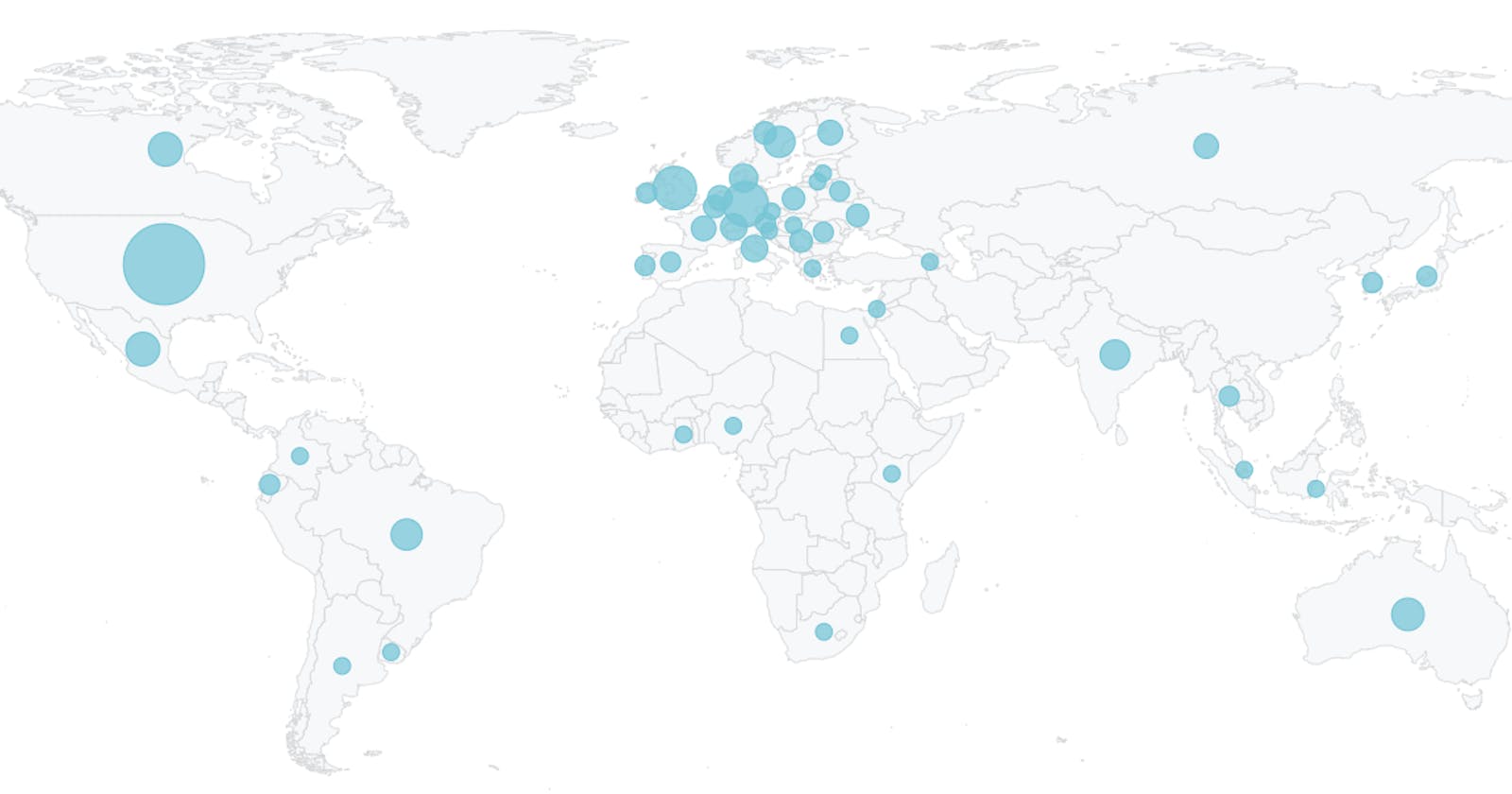I recently released my first Udemy course, F# From the Ground Up. My main aim (apart from making a dime, of course) is to help bridge F#'s 'beginner gap'. I think the course is succeeding in those terms, but it's had an unexpected side benefit. It gives a really interesting statistical window on the F# community, and on interest in F# generally. Unlike many hot takes on programming languages, these stats result from actual people parting with their (or their company's) hard-earned cash. So there is a degree of realism here which is missing in more broadly-cast nets like the TIOBE index or various consultancy-driven "tech radars".
"Within a week the course had been purchased in 42 countries"
The thing which blew me away almost as soon as the course launched was the global spread of interest in F#. Within a week, the course had been purchased (or accessed through Udemy for Business) in 42 countries:
The figure at the time of writing is 49. Although the centres of gravity are in North America and Europe, there is also a good scatter of customers in Africa, South East Asia and Central and South America. I cannot tell you how happy this makes me.

I'm hoping Aotearoa/New Zealand or China will crack soon and push me over the 50.
"Faites plaisir à vos ordinateurs..."
Here are the top ten countries by rough percentage:
| Country | % Students |
| United States | 32% |
| Germany | 8% |
| United Kingdom | 7% |
| Canada | 4% |
| Mexico | 4% |
| Australia | 4% |
| Brazil | 3% |
| Sweden | 3% |
| India | 3% |
| Denmark | 2% |
If you are wondering about France: those folks really don't like us! France is languishing at number 14, behind Finland. Come on France, faites plaisir à vos ordinateurs.
Edit:
Reddit user /u/skdoesit has kindly given me a clue as to France's surprisingly low positioning:
In France, Ocaml is part of the curriculum in what we call « classes preparatoires » ( a 2 year intensive preparation for the « grandes écoles »). I think the shift from Ocaml to F# is quite straightforward, hence the reason you have less french students (I think).
Course example from one of the best prépa : info-llg.fr/option-mpsi/?a=cours
Goes to show there's a story behind every statistical anomaly! Thanks skdoesit!
We can also say a little about the skills background of students. Here are the top 10 other programming languages/frameworks for which my students have purchased Udemy courses recently:
| Language | % |
| Python | 14% |
| C# | 10% |
| JavaScript | 10% |
| React | 8% |
| Rust | 7% |
| Node.js | 7% |
| C++ | 6% |
| TypeScript | 6% |
| Java | 6% |
| Go | 5% |
It's important to note, these aren't necessarily people's programming backgrounds, just courses they've bought in the previous few months. So it indicates more a direction of travel for students interested in F#.
"...the percentage of signups who are women is nearer 2%"
Something I'm much less happy about is the gender gap. Sources vary on the percentage of coders in general who identify as female, but it seems to be in the range of 10 to 20% - which is pretty catastrophic to start with. Judging by first names (from cultures where I recognize these) the percentage of signups who are women is nearer 2%. This makes me sad and it should make you sad.
If there is anything I can do to fix it, for this or future courses, please let me know by DM on Twitter or email on kit at kiteason dot com.
"The landing page conversion rate is ... 12.5%"
Since "F# From the Ground Up" became available within Udemy for Business about 40% of students have come to the course from that route. But by far the biggest marketing channel for me is Twitter, thanks in part to some very generous retweets and endorsements from Don Syme, Phillip Carter and others.
The landing page conversion rate is a very healthy 12.5%.
Finally, my favourite statistic:
Since that tweet the figure has gone up to 21,533 minutes taught. That's an awful lot of beginner enthusiasm, which the F# community needs to nurture and capitalize on.
"Win a code to join the course completely free"
As a thankyou for reading this far, here's a quick competition:
I mentioned above that, at the time of writing, France comes 14th in the list of countries where people have kindly purchased the course, behind Finland. Can you guess which two countries came 11th and 12th? As a clue, one of these countries is in the EU, one is not, and yet they share a border with one another.
The first three correct answers to reach me by DM on Twitter or email on kit at kiteason dot com will win a code to join the course completely free. If you don't need this beginner course yourself, you'd be very welcome to nominate someone else. Imagine their tears of joy.
